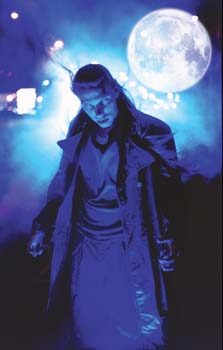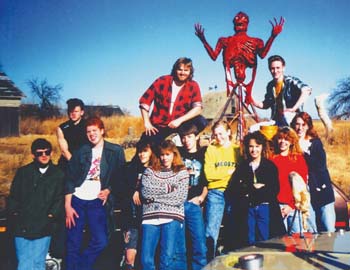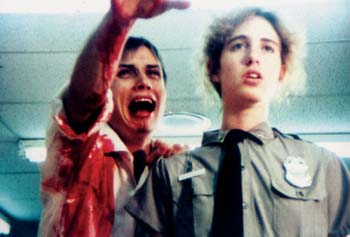 Oct. 22, 2004: The house lights dim in Wichita’s Old Town Warren Theatre in preparation for the world premiere of Leif Jonker’s Darkness.
Oct. 22, 2004: The house lights dim in Wichita’s Old Town Warren Theatre in preparation for the world premiere of Leif Jonker’s Darkness.
Though tonight’s film is of the genre known commonly as “splatter,” a seedy sub-division of horror featuring exploding heads, gruesome chainsaw mayhem and rivers of fake blood, there’s nary an empty seat to be had.
Why have so many seemingly normal people come to see such a stomach-churningly graphic film as Darkness?
The simple answer: About half the audience is made up of the movie’s cast and crew — and they’ve been waiting 16 years to see the finished product.
The Darkness saga began in 1988, when director Leif Jonker fs ’87 started shooting principal photography for the film at the tender age of 19.
With a microscopic working budget (about $5,000) and an army of willing (mostly teenage) volunteers, Jonker set out to prove he could make a feature-length film on the slimmest of shoestrings.
“The fact is, I had tried to raise a ‘real’ budget,” Jonker says. “I was trying to raise a hundred K and one guy in particular told me he couldn’t film the first ten minutes of Darkness for a hundred thousand dollars.”
Working a variety of odd jobs, including forklift driver, dishwasher, night-shift hotel clerk and plasma donor (“Yes, I sold my blood to make a vampire movie,” he is fond of saying), he put together enough pocket change to keep moving the project along. In the spirit of keeping everything within the film’s meager budget, everything from costuming (actors for the most part wore their own clothes) to the surprisingly realistic special effects was done on the cheap.
“It almost ruined gore films for me for a while because I saw the tricks of the trade,” says Veronica (Dennen) Laflin ’99, who acted in the movie and worked on the production crew. Referring to the fake blood used in the film, she adds, “I knew firsthand what corn syrup down the throat tasted like. I couldn’t eat pancakes for about a year and a half.”
Out of necessity, Jonker wore many hats during the production. “Aside from writing, producing, directing, appearing as a vampire extra and co-creating the special makeup effects, I shot the film, did all the lighting and recorded the sound on the set,” he says. “I was the propmaster, I performed the majority of the grip and electric work, I co-composed and performed the music with Michael Curtis, I edited the film and did all the original post work — the list goes on. Hey, you gotta do what you gotta do.”
It took two years to finish shooting the film; two more would pass before Jonker found a facility where he could edit the footage into a more-or-less finished movie.
Shot on Super 8 film, the entire project was intended to be akin to “a garage band demo tape,” a showcase for his talent, not a slick, smooth Hollywood production. The original videotape master was made by projecting the film onto a piece of spray-painted posterboard and capturing the image with a camcorder.
Jonker hoped “somebody would be impressed with it enough to put up the real cash for me to remake it at a higher level.”
Surprisingly, a number of distributors told Jonker that they considered this “demo tape” good enough to release on home video. In 1994, Darkness was unleashed on the American market, warts and all.

Members of the cast and crew of Leif Jonker's
Darkness take a break from shooting the film's
legendary, head-exploding climax. Director
Jonker (in red plaid shirt) and actor/effects-whiz
Gary Miller (upper right) flank one of their prized
homemade props, a self-destructing vampire
corpse.
And then something strange happened — people liked it. Special-interest publications such as Fangoria, Movie Maker, Film Threat, Independent Video and others devoted generous coverage to the grainy little splatter film.
The TNT network’s noted B-movie critic, Joe Bob Briggs, gave it a three-star rating, lauding the movie’s “impressive gross-out special effects.”
Soon, distributors in Spain, England, Japan, Germany and the Netherlands were calling Jonker. Darkness was released on videotape in those countries, and even went on to see DVD releases in Germany and Japan.
Jonker’s movie was a certifiable hit — at least in the underground world of “microcinema.”
Nearly a decade passed, with Jonker toiling away at a West coast production company, hoping to find financing to shoot another film. Darkness was screened a handful of times in theaters around the country, including a 1995 showing at Wichita State’s CAC Theater, but despite its cult following, the film seemed doomed to remain a grainy novelty.
Frustrated but unbowed, Jonker returned to Wichita and redoubled his efforts to locate backers for his work. One of those he turned to for help was Lonny Quattlebaum ’02, a videographer at WSU’s Media Resources Center.
“I wasn’t involved with the original cut,” says Quattlebaum, “but it was the film that got me excited about filmmaking and editing. Leif being from Wichita and getting his film nationally distributed got me excited about the opportunities. I worked on the latest version (of Darkness). I helped cut the first ten minutes as an example of how the newly-digitally-transferred stuff looked compared to the original. It looked a lot better.”
Jonker’s work came to the attention of Rick Pour, a filmmaker and special effects mastermind who was in the process of starting his own production company, Evolution Entertainment East, in North Carolina.
Pour convinced Jonker to come on board with the promise that their first joint project would be a completely remastered, top-quality edition of Darkness, followed by an official domestic DVD release.
And the rest, as they say, is history. The Warren Theatre screened the newly-mastered and re-edited Darkness as a midnight movie every night in the week between its premiere and Halloween — and sold 15 times more tickets than late-night screenings of the popular Hollywood horror flick Scream in the same theater.

Darkness, Jake Euker and Veronica (Dennen)
Laflin '99 await Liven, the unstoppable king of
vampires. Euker was nominated for a Drive-In
Academy Award for his "blubbering, hysterical"
performance.
“I saw it when it premiered at the Warren,” says Quattlebaum. “It was definitely a pretty grand improvement in image quality, and I thought the story was tighter, too.”
Laflin, now senior keeper of amphibians, reptiles and fishes at the Sedgwick County Zoo, agrees. “I thought it was great. It was so much better than the VHS version, and it was fun to watch,” she says. “I was really proud to be a part of it. Anyone who ever met me has seen at least the first five minutes — I’ve shown it to everybody. (In the new version,) Leif took out a lot of the long, dark scenes. I was really impressed.”
One might wonder what comes after Darkness for Leif Jonker. Not surprisingly, he’s got plenty up his sleeve. Leif Jonker’s Darkness: The Vampire Version is currently making the rounds at film festivals; two sequels are already in the works, and the long-awaited DVD should hit the shelves this summer.
Jonker is proud of his achievements, but looks forward to finally putting Darkness in the past and moving on to new projects.
Always looking for an angle, he says, “Hey, if you can work into the story that we’re currently looking for private investors for Darkness II, Skull Full and a variety of other low-budget projects, that’d be great.”





